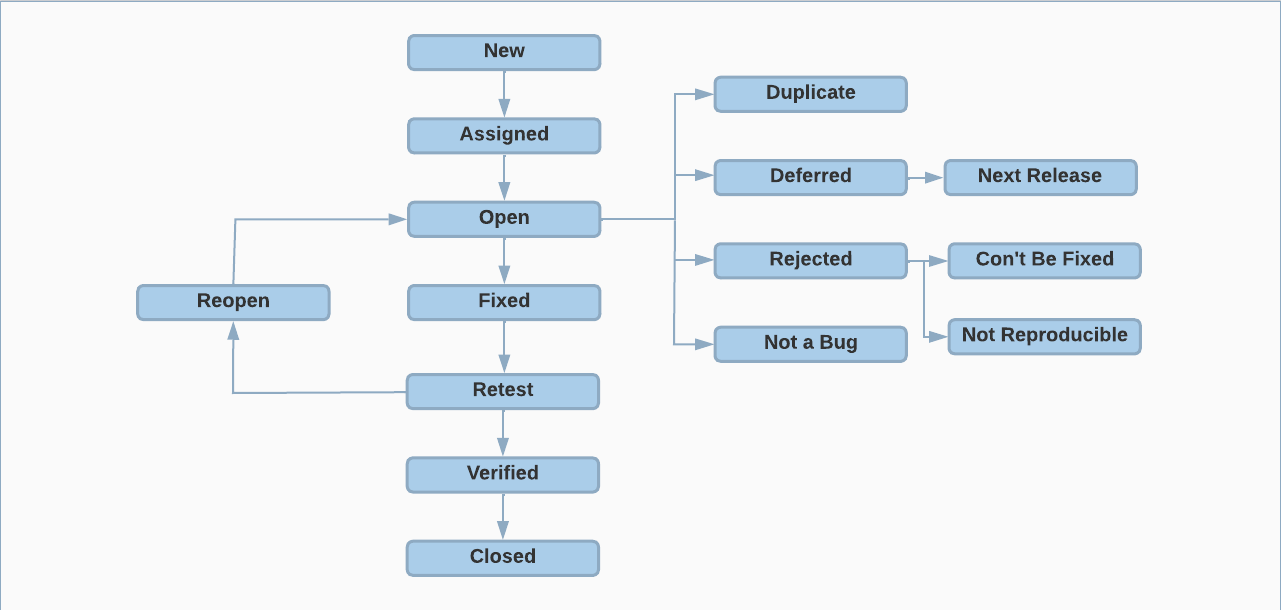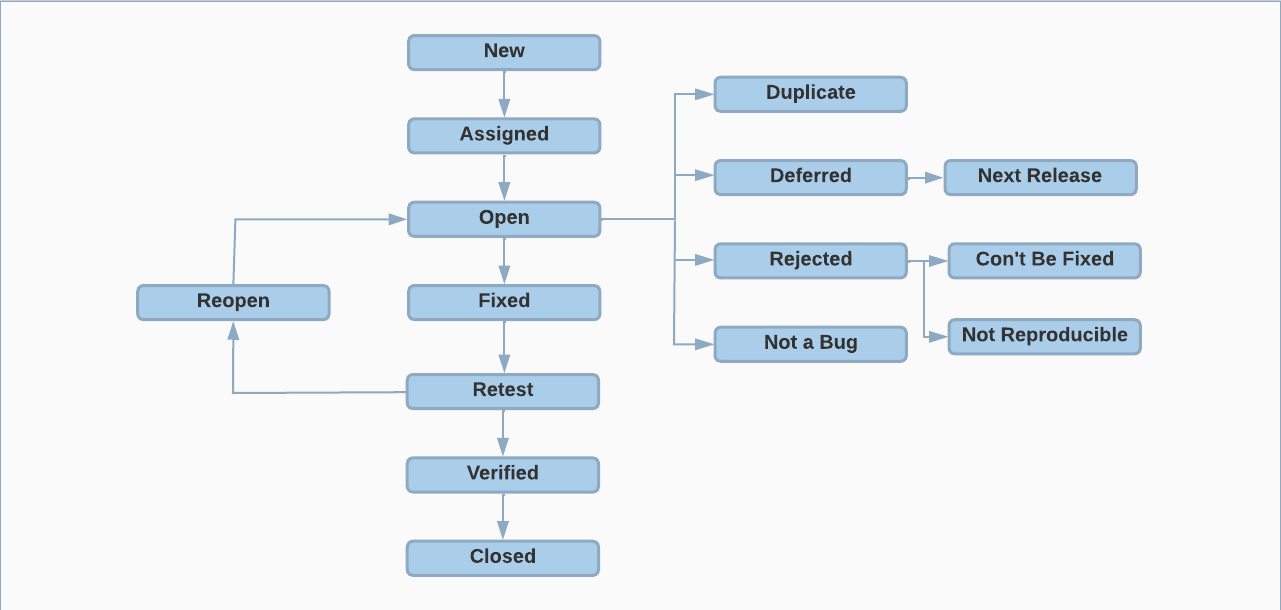Understanding Bug/Defect Life Cycle in Software Testing
 Safa Emhemed
Safa Emhemed
During software development, different types of defects/bugs show up with the software. These bugs/defects are identified by testers and resolved by developers throughout the development process to deliver good-quality software. In this post, we'll take you through everything you need to know about the Bug Life Cycle
What is a Software Bug/Defect?
A software bug/defect can be defined as the abnormal behavior of the software. The bug starts when the defect is found and ends when a defect is closed, after ensuring it is not reproduced.
What is The Bug/Defect Life Cycle?
The bug/defect life cycle is the specific set of states that a defect or bug goes through. Mainly bug life cycle refers to its entire state starting from a new bug/defect detected to the closing of that bug/defect by the tester.
The number of states that a bug/defect goes through varies from organization to organization and also from project to project depending upon the different tools used and processes followed during the testing of software.
The purpose of the Bug/Defect life cycle is to efficiently coordinate and communicate the current status of defects which changes to various assignees and makes the defect-fixing process systematic and efficient.
Stages of a Bug/Defect Workflow:
Below, you will find information about the frequently used statuses that designate different stages of the bug/defect management process. Some of them are mandatory and some are optional, used to provide more details about the progress.

- New
It is the first state of the lifecycle whenever a new bug is found by the tester, it is assigned a new state, and then the process of testing and validation starts, which leads to new states.
- Assigned
Defects that are in the status of New will be approved and assigned to the development team to work on. Once the defect is assigned then the status of the bug changes to "Assigned".
- Open/Active
In this "Open" state the defect is being addressed by the developer team and the developer team works on the defect for fixing the bug. Developers will start working on the bug according to the requirements.
There are also chances that the issue won’t seem appropriate, in that case, the developer can transfer the issue to these four states based on specific reasons.
Duplicate
If the defect is repeated twice or the defect corresponds to the same concept as another defect, the status is changed to "Duplicate" by the development team.
Deferred
If the present bug is not of a prime priority and if it is expected to get fixed in the next release, then the status "Deferred" is assigned to such bugs
Rejected
If the developer feels the defect is not a genuine defect or it's just due to some misinterpretation then it changes the defect to "Rejected". The cause of rejection may be any of these i.e Can't Be Fixed, Non-Reproducible.
Non-Reproducible
If the defect is not reproduced due to platform mismatch, data mismatch, build mismatch, or any other reason then the developer marks the defect as in a "Non-Reproducible" state.
Can't Be Fixed
If the developer team fails to fix the defect due to Technology not supporting, the Root of the product issue, the Cost of fixing a bug is more and any other reasons then the developer team marks the defect as in "Can’t be fixed" state.
Not a Bug
If the defect has no impact or effect on the program’s functionality of the software then it is marked as "Not a Bug" state.
- Fixed
After the developer analyzes the bug and makes the code changes to fix it, they can mark the state as "Fixed" and forward it to the testing team for further processing.
- Retest
When the tester starts testing the issue again, at that point the issue falls in the retest phase. The tester will check again if the developer fixed the bugs as per requirement or not.
- Reopen
If the defect remains the same after the retest even after the developer has fixed the bug, the tester changes the status to "Reopen".
- Verified
The tester re-tests the bug after it got fixed by the developer. If there is no bug detected in the software, then the bug is fixed and the status assigned is "verified".
- Closed/Done
This is the final stage of the bug life cycle. After the tester verifies the fix if the bug no longer exits then the status of the bug will be assigned as "Closed".
Remember: During the entire bug life cycle, the status of the bugs can change multiple times depending upon the situation and the number of states that a bug/defect goes through varies based on many aspects.
How to Create a Bug Report?
A bug report is a document containing the problem the testers discovered so the development team can fix it. When writing a bug report, you must keep it simple and to the point because a good bug report is detailed and repeatable. Also, ensure you reproduce the bug yourself before filing a bug report to ensure it exists. Check the article How to Write an Effective Bug Report?
How to Report and Track a Bug?
Reporting and tracking a bug depends upon the tool you use. Using a professional tool, you can record, report, and monitor bugs during the software testing process. A bug-tracking tool ensures that all the bugs are detected and fixed.
Here's a brief description of some Popular Bug Tracking Software:
- Zoho bug tracker
Zoho Bug Tracker is a defect tracking tool that lets you create custom fields and workflows and personalize your interface to catch any software bug. Can Submit, track, and fix bugs with the help of automation and numerous software customizations.
- GitHub
GitHub Issues is a bug-tracking system available in all GitHub source code repositories. In addition to issue management, development teams can use GitHub to host discussions, process internal customer support requests, and submit documentation feedback.
- Jira
Jira is an issue-tracking and agile project management tool that helps software teams capture, assign, and prioritize bugs. QA teams can build custom workflows to keep track of status changes. Jira workflows are displayed on digital boards that capture the status and transitions of each task within a project.
- Trac
Trac is an open-sourced bug tracker that you can use to stay on top of issues in software projects. This wiki-styled tool uses a minimalist approach to manage projects on the web and help developers create great software.
- ClickUp
ClickUp is a highly customizable bug-tracking tool that allows you to create your custom views. It provides wall-to-wall solutions for organizations needing to stay productive and efficient. It helps you to set priorities for the work with no hassle.
There are numerous bug-tracking tools make sure to choose the right tool for your organization. Without the best bug-tracking system, you risk increasing your product development costs, losing customers, and even decreasing your software’s quality.
Conclusion
The bug life cycle in testing refers to a cycle of defects in which it goes through different states throughout its life, testing, and development teams work side by side in this cycle so they can deliver high-quality software. The goal of the bug/defect cycle is to precisely convey the current state or progress of a defect or bug in order to better track and understand the actual progress. To make this communication smooth and to ensure that all errors are fixed timely, it is important to incorporate tools that can help to smoothen the whole process and write clear and bold bug reports.
Subscribe to my newsletter
Read articles from Safa Emhemed directly inside your inbox. Subscribe to the newsletter, and don't miss out.
Written by

Safa Emhemed
Safa Emhemed
I'm a QA engineer at Libyan Spider, and I co-founded the Averto App. I’m also a certified Trainer of Trainers (TOT) and love volunteering as a trainer with Google Developer Groups (GDG). It’s all about sharing knowledge and pushing tech forward!